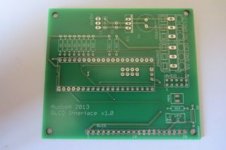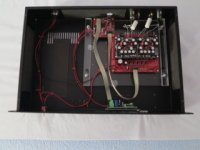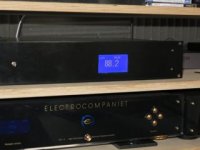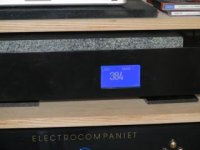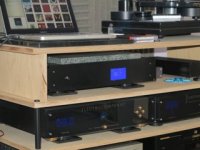It is useful I find. Easiest would be to use google translate. I might be able to translate it but it will take a while since I'm pretty busy the next couple of weeks. The essence of the article though is this: All the transformers in that test "suffice". That is to say that none of them are bad. The reviewer found the Cinemag to be the best of the three under test all things considered. He was dissapointed that he was not able to test it head to head in a listening session with the Sowter 3575 because the he did not have the Sowters anymore. The Magnequest sounded more powerful but the "depth of the soundstage" and the " better seperation" made the Cinemag top of the pops subjectively for the person doing the listening.If this is usefull for all, maybe someone from Netherland can post a summary of that test in english.
Also he prefers the output transformers over perhaps any capacitor in the DDDAC1794.
He found the Cinemag best of the three. But even more so taking into consideration the price. Which gives it a slightly different meaning.Cinemag CMLI 15/15B is good for the price.
Last edited:
wow, thats the first time i've ever heard someone deliberately increasing the likelihood of RFI, EMI, lowering CMRR, raising distortion (well this one seems quite popular). its basic housekeeping stuff, not pedantic, but hey whatever makes you happy.
here is what the designer wrote about it -
if you put two wires in close proximity then they talk to each other and you create a capacitor that means that v high frequency information bleeds between then. So if L and R channel signal then you lose seperation, if + and - of the same leg then you lose some of the v high frequency information of the music as the cable is acting as a filter. If you then twist the cable you put the cable in even closer proximity which increases capacitance again and also introduces a small inductive element into the load.
I see no logic in their statement as all they can be referring to is stray RF which it will remove along with some of the musical content.
Try both ways and do what your ears tell you.
well to be honest i can't be arsed - he doesn't on his amps for the above reasons. have you considered that there may be an upside?
so you're saying that we should only twist one channel and Ground ?
and of course it helps twisting the power cables
-but can we use coaxial for internal wiring ? i think ou can twist them on a stick until some effect is noticed -comes with over 61pf capacitance though between ground and middle cable
and of course it helps twisting the power cables
-but can we use coaxial for internal wiring ? i think ou can twist them on a stick until some effect is noticed -comes with over 61pf capacitance though between ground and middle cable
Coaxial is bad for sound as Spacejay says. But also the plastic isolation (dielectric) has audible effect. Interesting reading on this topic: " the supercables cookbook" by Allen Wright.
It is also true that open cabling introduces a loop in the system that can pick up electromagnitic fields.
So it is important to use both coaxial/twisted and seperated cabling in your system at the right spot. I use speaker cabling with the two wires seperated 30cm from each other. This is much better than twisted (what I also tested) but in high frequency designs, such as USB cables, twisted is better for RFI rejection ( but I found it not suitable to use coaxial here).
It is also true that open cabling introduces a loop in the system that can pick up electromagnitic fields.
So it is important to use both coaxial/twisted and seperated cabling in your system at the right spot. I use speaker cabling with the two wires seperated 30cm from each other. This is much better than twisted (what I also tested) but in high frequency designs, such as USB cables, twisted is better for RFI rejection ( but I found it not suitable to use coaxial here).
here is what the designer wrote about it -
if you put two wires in close proximity then they talk to each other and you create a capacitor that means that v high frequency information bleeds between then. So if L and R channel signal then you lose seperation, if + and - of the same leg then you lose some of the v high frequency information of the music as the cable is acting as a filter. If you then twist the cable you put the cable in even closer proximity which increases capacitance again and also introduces a small inductive element into the load.
I see no logic in their statement as all they can be referring to is stray RF which it will remove along with some of the musical content.
Try both ways and do what your ears tell you.
well to be honest i can't be arsed - he doesn't on his amps for the above reasons. have you considered that there may be an upside?
no, there is no upside. who said anything about twisting everything together? you havent twisted anything at all, you have everything just flopping around, the ground wires are not even close to the signal wire , let alone twisted. each signal should be twisted with its ground, or if balanced, it should be twisted with its opposite polarity. i'm not saying all the wires should be twisted into a bunch.
the bold bit is, i'm afraid, nonsensical … +/-, or +/G are 2 parts of the same signal, the signal is induced between the 2 and in solid state electronics for example current is more correctly described as flowing from ground, not to it. none of the signals are VHF and if they were, it would be even more important to have ground and signal, or + and - in close proximity. the signal doesnt travel up the signal wire and then dribble out into ground
xslavic: coax can be useful for single ended low level signals, but for balanced twisted pair is superior.
I cannot think of a single reason to separate a signal and its return leg, not least by 30cm, this makes for huge inductance and makes it more likely to pick up and transmit noise. speaker cables are driven reasonably hard, so its maybe not as noticeable, I dont know what was going on in your system, but there is no good reason to make loop area larger.Supersurfer said:I use speaker cabling with the two wires seperated 30cm from each other
there seems to be a fair few odd assertions going on here … this is all pretty basic signal integrity stuff
Last edited:
I/V Resistor Trials
So after this and the other posts on the differing I/V resistor types I invested in 4 off Audio Note tantalums and 4 off Amtrans AMRG carbon film , all 68 Ohm as I have a two board setup.
Compared to the Dales both are a significant improvement. Both provide more clarity to the music and by that I mean the ability to hear more detail, the removal of another veiling layer. Particularly noted is the better differentiation between instruments and the space around them. Also to note is the increased dynamics and the ability to respond to the rate of dynamic increases. One surprising affect clearly heard though was the better rhythmic interplay between musicians. (This reminds me of the Naim PRAT argument !).
Take for example the Art Blakey and the Jazz Messengers track, "A night In Tunisia". Both of the above provided much better interplay between the players. When all are playing together the Dales were somewhat muddled and differentiating them was more difficult. With both the ANs and Amtrans each player clearly had their own space in the acoustic and the ability to hear the interaction between them much increased.
Both also took off a slight hard edge to the Dales presentation, the Amtrans providing a much 'smoother' , somewhat 'laid back' presentation compared to the ANs but both far better than the Dales. Th dynamic rate changes were some what slower than the ANs here.
My output is balanced with no decoupling caps., wired with Jupiter silver wire in cotton, so is a very direct output, perhaps helping to hear the above more than the single ended connection ?
Hope this helps .
Regards
Howard
Hi Howard,
Please keep us posted on your findings.
Regards,
So after this and the other posts on the differing I/V resistor types I invested in 4 off Audio Note tantalums and 4 off Amtrans AMRG carbon film , all 68 Ohm as I have a two board setup.
Compared to the Dales both are a significant improvement. Both provide more clarity to the music and by that I mean the ability to hear more detail, the removal of another veiling layer. Particularly noted is the better differentiation between instruments and the space around them. Also to note is the increased dynamics and the ability to respond to the rate of dynamic increases. One surprising affect clearly heard though was the better rhythmic interplay between musicians. (This reminds me of the Naim PRAT argument !).
Take for example the Art Blakey and the Jazz Messengers track, "A night In Tunisia". Both of the above provided much better interplay between the players. When all are playing together the Dales were somewhat muddled and differentiating them was more difficult. With both the ANs and Amtrans each player clearly had their own space in the acoustic and the ability to hear the interaction between them much increased.
Both also took off a slight hard edge to the Dales presentation, the Amtrans providing a much 'smoother' , somewhat 'laid back' presentation compared to the ANs but both far better than the Dales. Th dynamic rate changes were some what slower than the ANs here.
My output is balanced with no decoupling caps., wired with Jupiter silver wire in cotton, so is a very direct output, perhaps helping to hear the above more than the single ended connection ?
Hope this helps .
Regards
Howard
Hi Howard,
Thanks for your analysis! You are right that the balanced setup is more reveiling in this area because the caps are out. I also use solid silver wiring with cotton (C37 laquered) this is the best!
I will try the tants after my summer holiday. The sound balance you describe compairs with my experience in tube amps. This does not mean the Dale are not good, they only change the sound balance.
The choice depends on the balance of your system (and maybe your ears )
)
Regards,
Thanks for your analysis! You are right that the balanced setup is more reveiling in this area because the caps are out. I also use solid silver wiring with cotton (C37 laquered) this is the best!
I will try the tants after my summer holiday. The sound balance you describe compairs with my experience in tube amps. This does not mean the Dale are not good, they only change the sound balance.
The choice depends on the balance of your system (and maybe your ears
Regards,
AudioH DDDAC MKII
MKII now finished with improved graphics display, so I can read it from a distance.
I designed a dedicated board for the graphics LCD to take the Teensy+ processor and associated parts. This was my first pcb so really pleased how it turned out.
DDDAC parts mounted on an acrylic base isolated from the main case by sorbothane isolators for vibration reduction.
Regards
Howard
MKII now finished with improved graphics display, so I can read it from a distance.
I designed a dedicated board for the graphics LCD to take the Teensy+ processor and associated parts. This was my first pcb so really pleased how it turned out.
DDDAC parts mounted on an acrylic base isolated from the main case by sorbothane isolators for vibration reduction.
Regards
Howard
Attachments
Hi Howard
That looks great. I've just finished building mine and had a first listen yesterday, sounds fantastic to me. Do you mind telling me where you got your enclosure from, it looks like it would match my croft pre and power amps perfectly.
Thanks, Si
It's a Maplin 2u 19inch rack unit . I milled out the LCD panel section.
Best regards
Any link that could help me understand why this choice and where to provide it?I also use solid silver wiring with cotton (C37 laquered) this is the best!
best regards
I have two transformers CMLI-15/15B2 (double shielded). I want them to join the DDDAC1794. I enclose a drawing chart. Is that okay? I do not need any capacitor at the output?
as far as I am concerned, there is no real need to connect the White and Black shielding. As I do not know the transformer, I cannot tell if the low frequency cut off will be sufficient, nor if it can handle the voltage Just try it out
Hi Doede. It is the Cinemag Dick and you listened to.As I do not know the transformer, I cannot tell if the low frequency cut off will be sufficient, nor if it can handle the voltage Just try it outnothing can go wrong
Hi Bas Horneman. Please help me with CMLI and DDDAC 1794. I want them to join the DDDAC1794. I enclose a drawing chart.
http://www.diyaudio.com/forums/digi...-pcm1794-waveio-usb-input-50.html#post3578968
http://www.diyaudio.com/forums/digi...-pcm1794-waveio-usb-input-50.html#post3578968
Hi jeremysk. That looks good. I am not sure how to connect the white and black wire either. But it will work as you have drawn it. I also have the Cinemags....and will connect them some time this week and will let you know what I did.I enclose a drawing chart.
As Doede has said: "there is no real need to connect the White and Black shielding". So try connecting all of the ground wires to common.White, Grey and Black.
Last edited:
VCC related chip mortality?
Hi, Doede,
I'm wondering whether you've experienced much in the way of shortened PCM1794A chip lifespan? If so, it might be traceable to supplying them with an 8.0 volt Vcc. While the PCM1794A do function at that high a Vcc, I should think that such an continuous over voltage supply condition would accelerate the chip's breakdown mechanisms.
Hi, Doede,
I'm wondering whether you've experienced much in the way of shortened PCM1794A chip lifespan? If so, it might be traceable to supplying them with an 8.0 volt Vcc. While the PCM1794A do function at that high a Vcc, I should think that such an continuous over voltage supply condition would accelerate the chip's breakdown mechanisms.
Last edited:
- Home
- Source & Line
- Digital Line Level
- A NOS 192/24 DAC with the PCM1794 (and WaveIO USB input)
